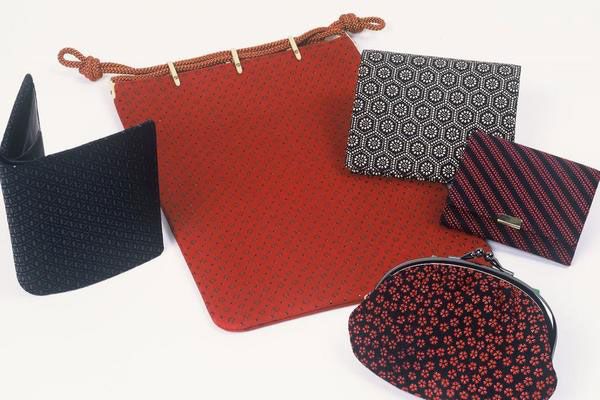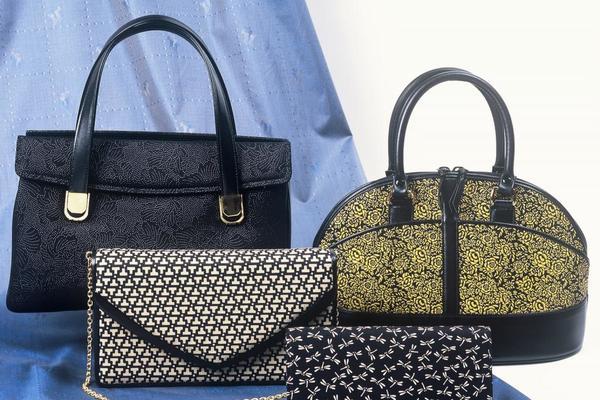 Photo:Yamanashi Tourism Organization
Photo:Yamanashi Tourism Organization
- Other crafts
- Yamanashi
Koshu lacquered deer leather Koshu inden
The meeting of buckskin and Japanese lacquer
Comfortable, light and soft leather
Description
What is Koshu lacquered deer leather ?
Koshu lacquered deer leather (called Koshu inden in Japanese) is a unique style of leathercraft that was developed in the city of Kofu, Yamanashi prefecture. Koshu lacquered deer leather is unique because of its combination of deer leather and urushi lacquer (Japanese lacquer). Today, there is a wide range of Koshu lacquered deer leather products like buckskin bags, wallets, and pouches. During the Sengoku period (1467-1603), this traditional leatherware technique was popular among samurai as part of armorware. The application of Japanese lacquer makes this soft and light leather more durable and long-lasting. Also, the leather gets more polished with use. One of the reasons for Koshu lacquered deer leather's popularity is its beautiful designs. These designs like small cherry blossoms, irises, or dragonflies depict the beauty of nature and four distinct seasons. Koshu lacquered deer leather is the only leathercraft in Japan that uses straw smoke and resin to cure and color the leather in a range of unique colors. This art requires a high level of craftsmanship and lots of experience. The technique of stenciling with paper patterns makes even the most detailed designs stand out. Historians believe that Shingen TAKEDA (feudal lord and military leader, 1521-1573) used an armor case made of Koshu lacquered deer leather to store his suits of armor. This craft has been loved in Koshu for a long time.
History
 Photo:Yamanashi Tourism Organization
Photo:Yamanashi Tourism Organization
Koshu lacquered deer leather has a long history as documents record its production area as being identifiable during the Edo period (1603-1868). The history of leather goods in Japan dates back to the Nara period (710-794), when techniques of tanning leather and patterning with Japanese lacquer were imported from abroad.
The name inden likely originates from the fact that between the years of 1624 and 1643, people from abroad offered Indian leather products to the Tokugawa shogunate (feudal military government). There are several theories about the origin of the word inden, such as Indo (meaning India in Japanese), or Indo denrai (meaning originated from India in Japanese). Even though inden crafts were probably made in every region during the Edo period, Koshu lacquered deer leather from Yamanashi is the only one to have been preserved and still produced today.
During the Meiji period (1868-1912), Koshu lacquered deer leather products such as cloth pouches and drawstring pouches won awards at the Domestic Industrial Exhibition resulting in inden becoming a well-known craft in Yamanashi. Then handbags started being made during the Taisho period (1912-1926). Finally in 1987, Koshu lacquered deer leather was designated as a Traditional Craft by the Minister of Economy, Trade and Industry.
General Production Process
- 1. Dyeing First, the surface of the deer buckskin is filed down and smoothed in preparation for lacquer application. Then around a hundred pieces of white buckskin are dyed in a dyeing machine as large as a washing machine. Each buckskin will be different from absorbing dye in a unique way, having natural texture brought out, and being dyed to its core. Afterwards, each white buckskin is tied down with chains and any remaining hairs are removed. Depending on the design, hemp thread is wound around the buckskin or patterns are glued before dyeing. The buckskins are also placed in a cylindrical bottle for straw smoking and coloring.
- 2. Cutting The rough cutting is done with a technique called aradachi. A variety of blades and knives are used to cut different items while trying not to produce any waste pieces. Sometimes two ends of leather do not meet, but this is regarded as the authentication of its natural quality. The fusube technique is used in the final cutting process.
- 3. Patterning There are multiple patterning techniques. In the urushi oki technique, a hand-carved stencil pattern made of traditional Japanese paper (washi) is placed on the leather and lacquer is applied evenly with a spatula. In the sarasa technique, colorful prints are created using a different paint for each hand-carved paper stencil pattern. Because Japanese lacquer is sensitive to temperature, humidity, and other seasonal factors, it requires many skills to apply evenly. It takes approximately 3 to 7 days to complete a typical article made of beautiful lacquered deer leather. In the fusube technique, chains are used on white buckskin to remove remaining fine fur. Depending on the design, hemp yarn is wound around the leather or patterns are glued in place before dying. Buckskins are dyed a honey color by straw smoking in a cylindrical drum. Some hides are smoked for 4 to 5 hours longer with resin to deepen the color from yellowish brown to brown. After removing the thread and glue, the patterned buckskins are dried in a drying room with a consistent temperature, before being left for a few days in an airy shaded room.
- 4. Sewing/Finishing For both the lacquer application and sarasa techniques, the patterned leather is cut to the shape of the design, rounded out to thin the edges, and sewn into the final piece. Hand stitching is carefully carried out along the edge as the Japanese lacquer patterned surface is uneven. Light hammering is used to shape the item, leather is sewn on the reverse side, and snaps, zippers or any other necessary parts are attached. Each item is meticulously inspected and only the highest quality pieces are awarded the inden label and shipped. With the production of Koshu lacquer deer leather smartphone cases and other daily use accesories, inden is loved by people of all ages.
Where to Buy & More Information
Indenya
-
Address
-
Tel.+81-55-230-1621
-
ClosedINDEN-YA main store closed and during exhibition change (please inquire in advance.)
-
Business Hours10am to 5pm
-
Website
See more Other crafts
- Edo kiriko cut glass
- Koshu lacquered deer leather
- Kyo folding fans
- Marugame uchiwa fans
- Boshu uchiwa fans
- Gifu lanterns
- Yamaga lanterns
- Kyo uchiwa fans
- Tendo Japanese chess pieces
- Edo glass
- Edo patterned paper
- Yame lanterns
- Owari Cloisonné
- Fukuyama Koto (Japanese Harp)
- Kyo art preservation
- Banshu fly-fishing flies
- Woodblock prints
- Koshu hand-carved seals
- Edo Hyogu (Art Mountings)
- Edo tortoise shell crafts
- Etchu Fukuoka Sedge Hats
- Gifu Japanese Umbrellas
- Nagasaki tortoise shell crafts
- Nagoya Sekku Kazari
- Sanshin
- Tokyo Koto (Japanese Harp)
- Tokyo Shamisen































































































































































































































































































